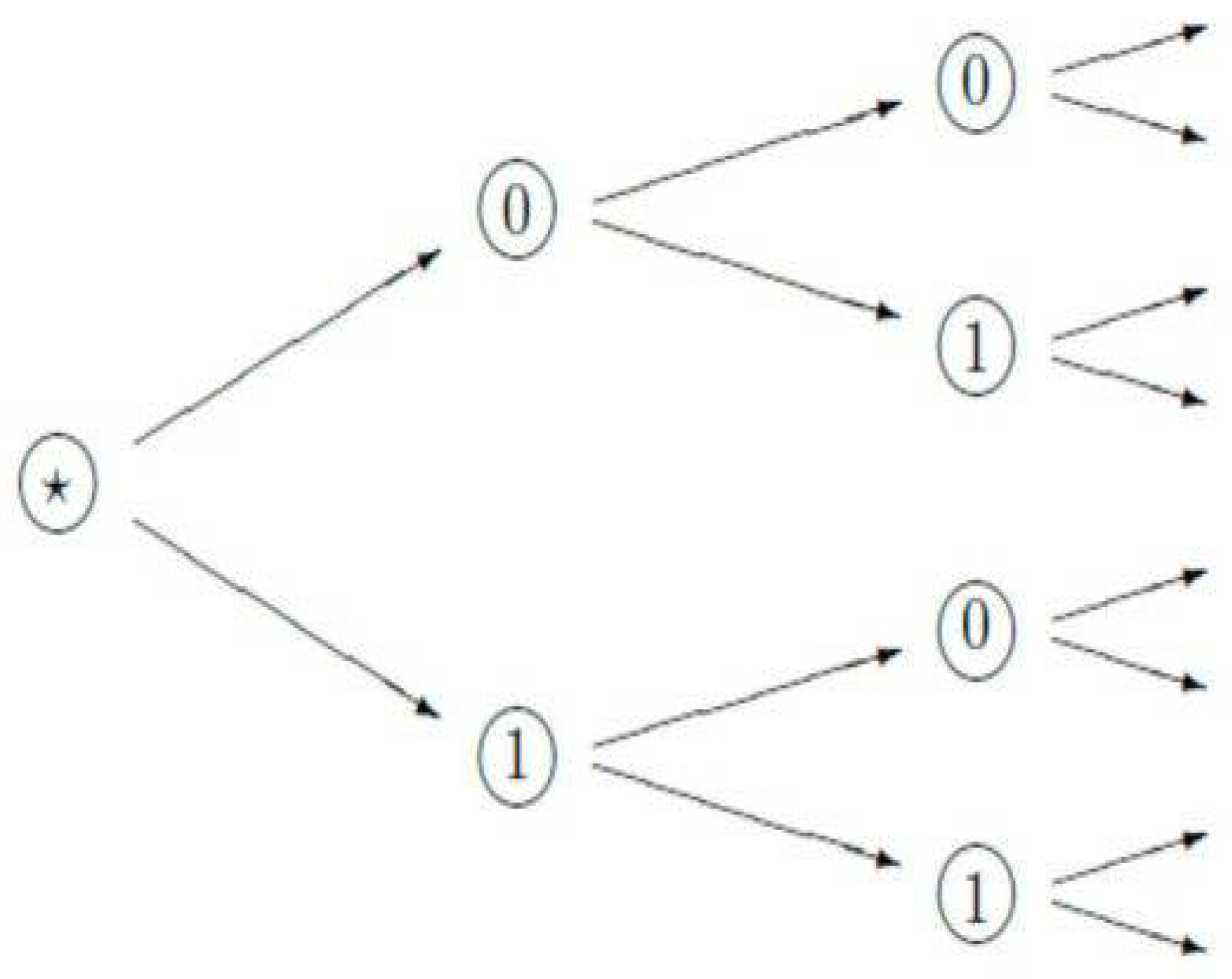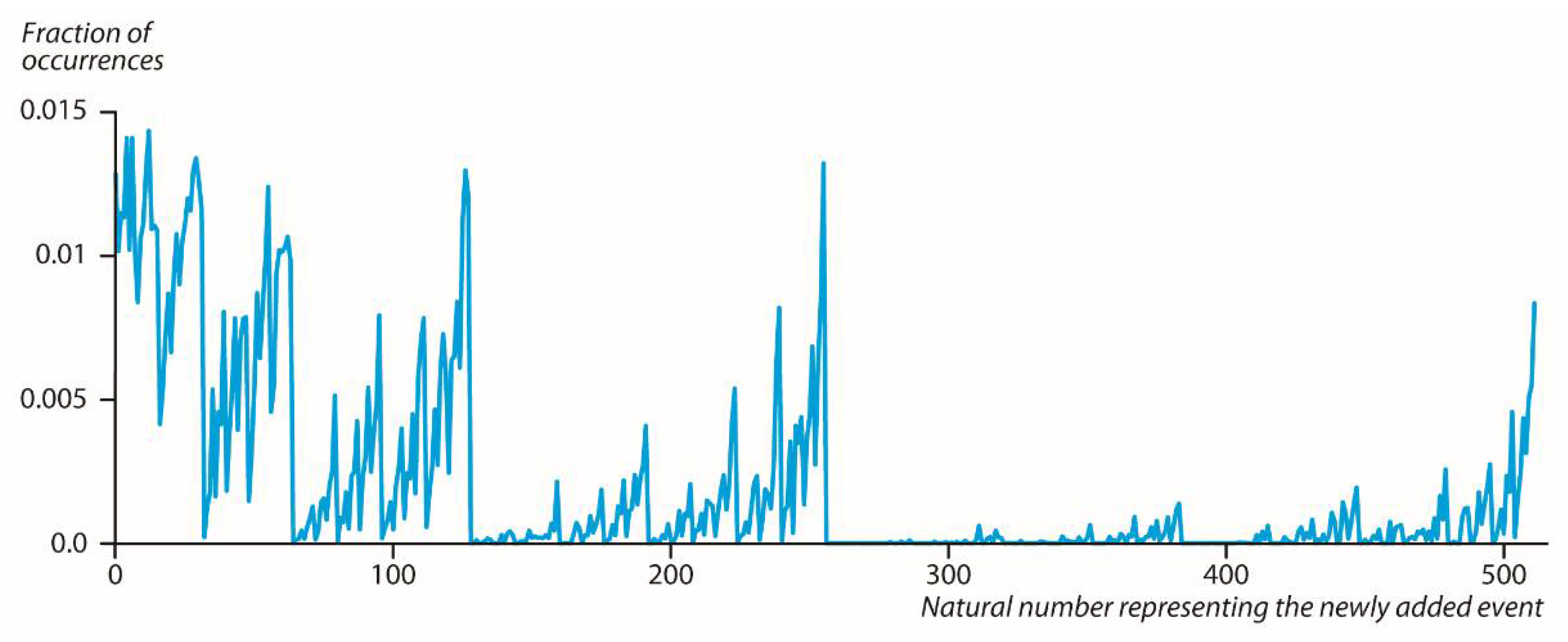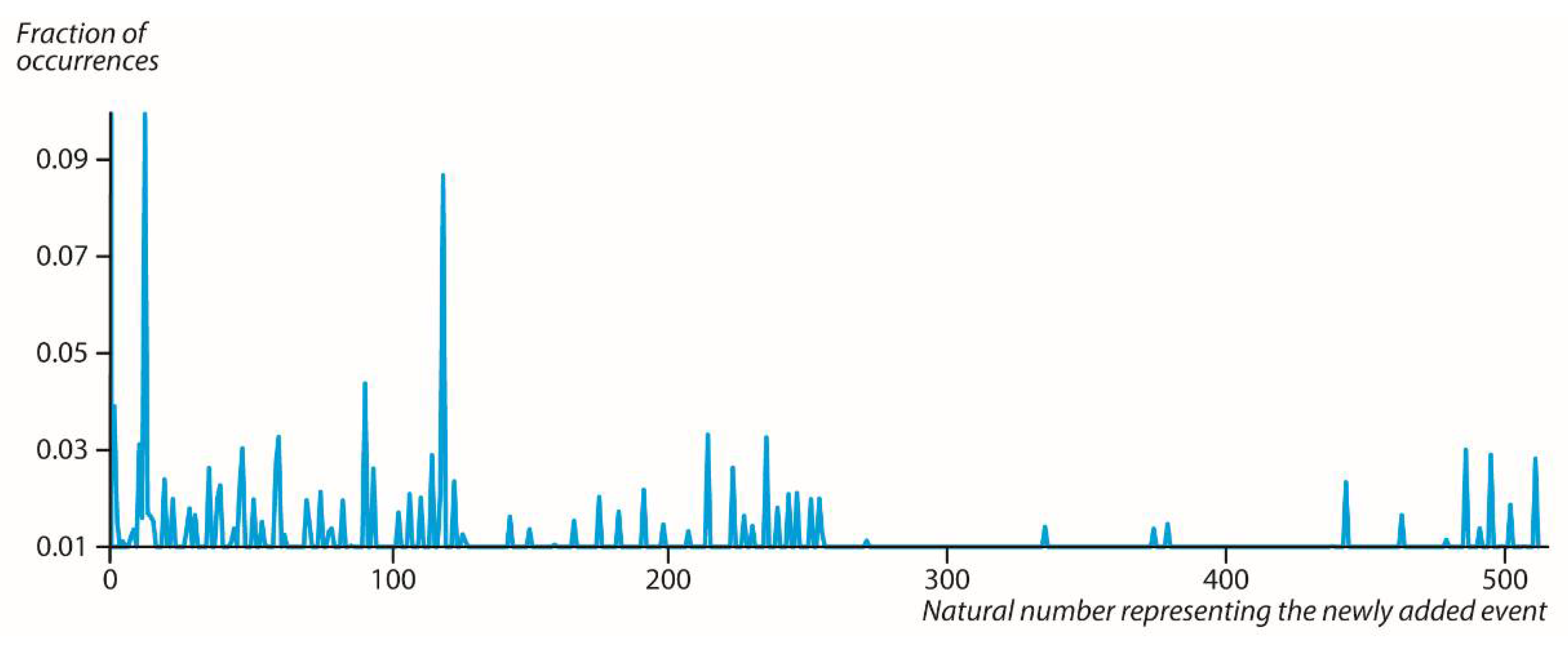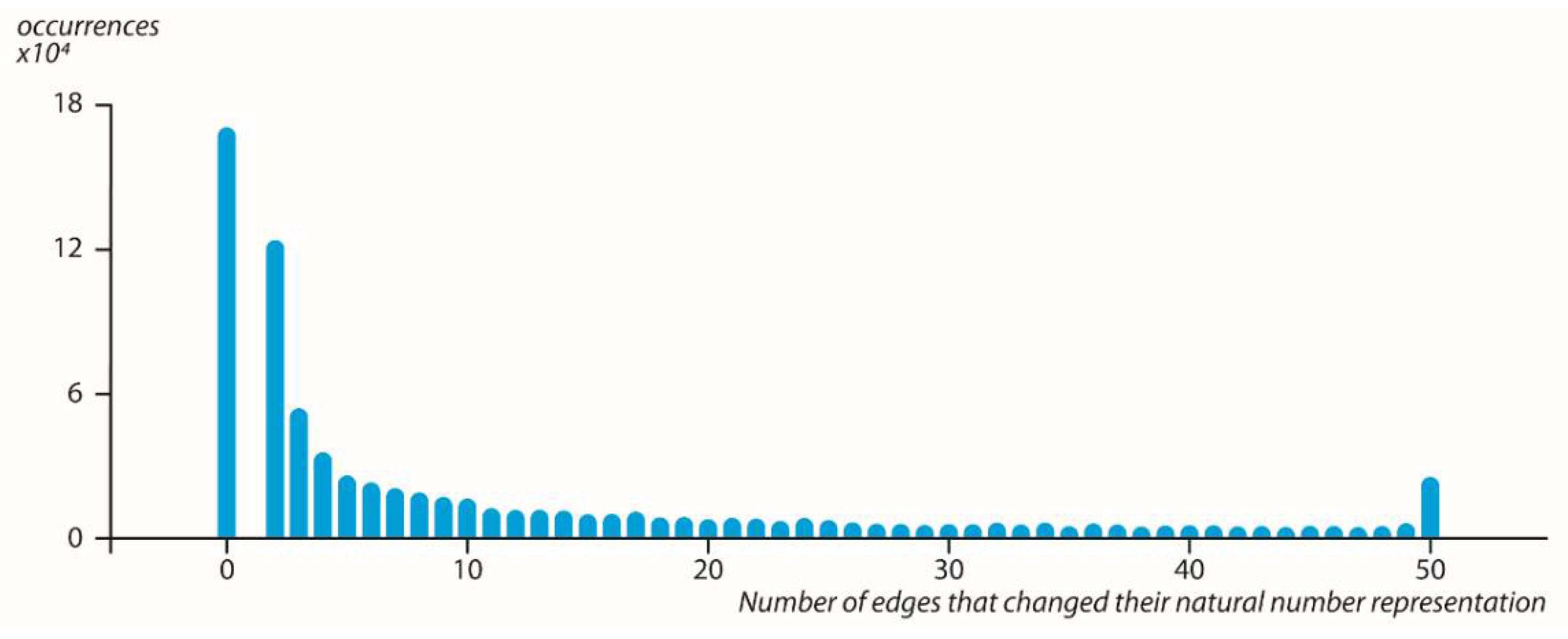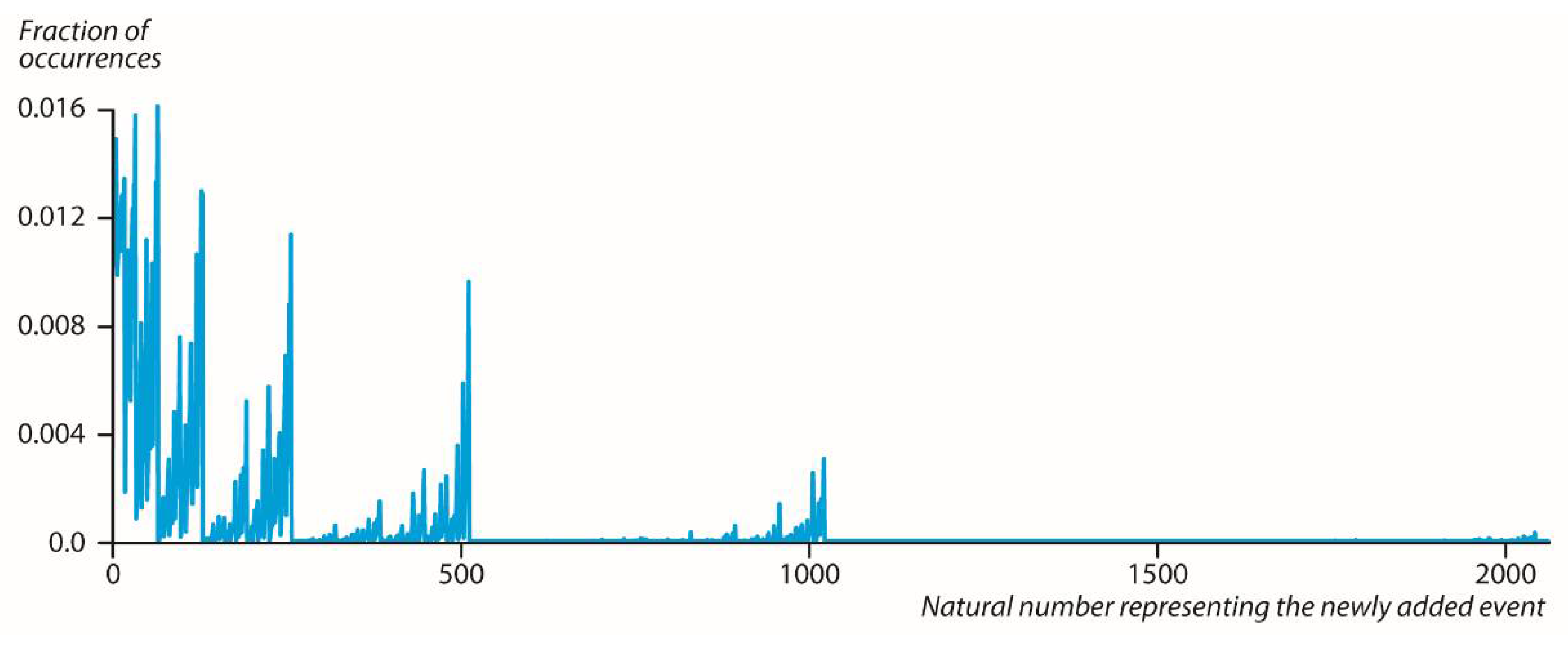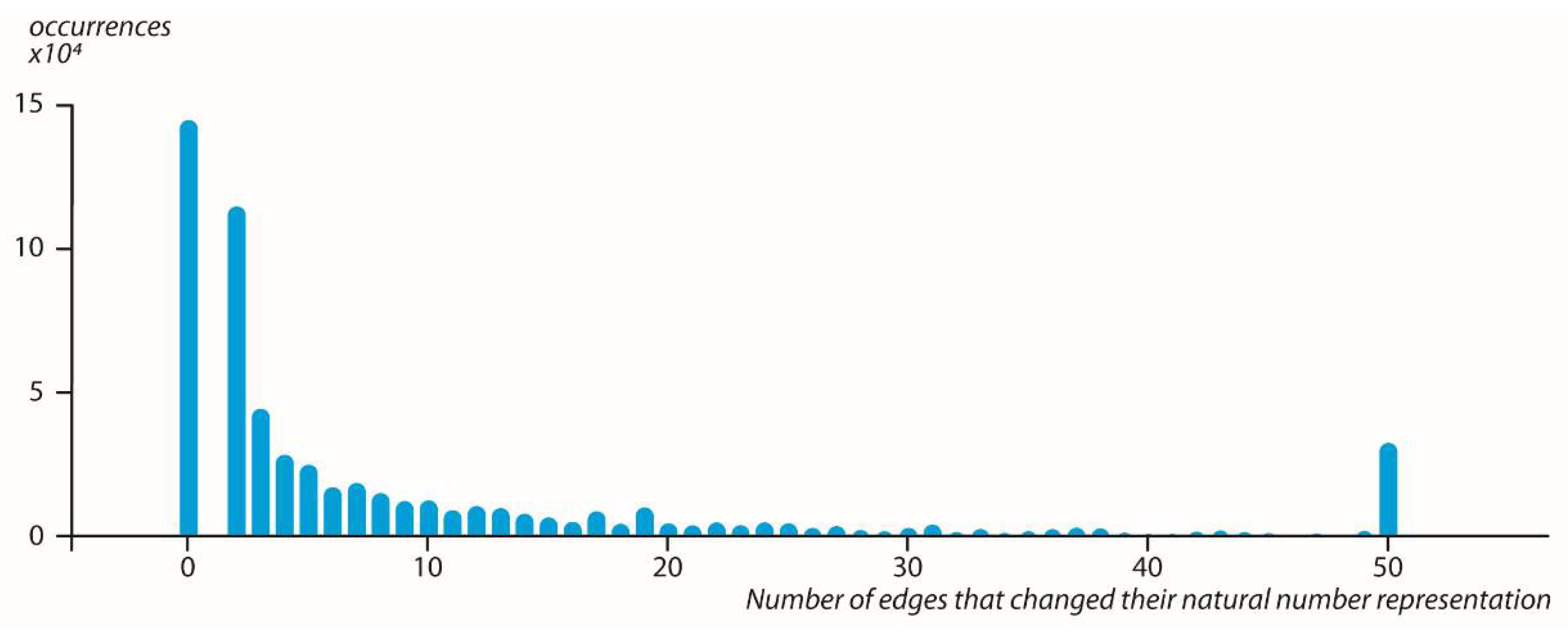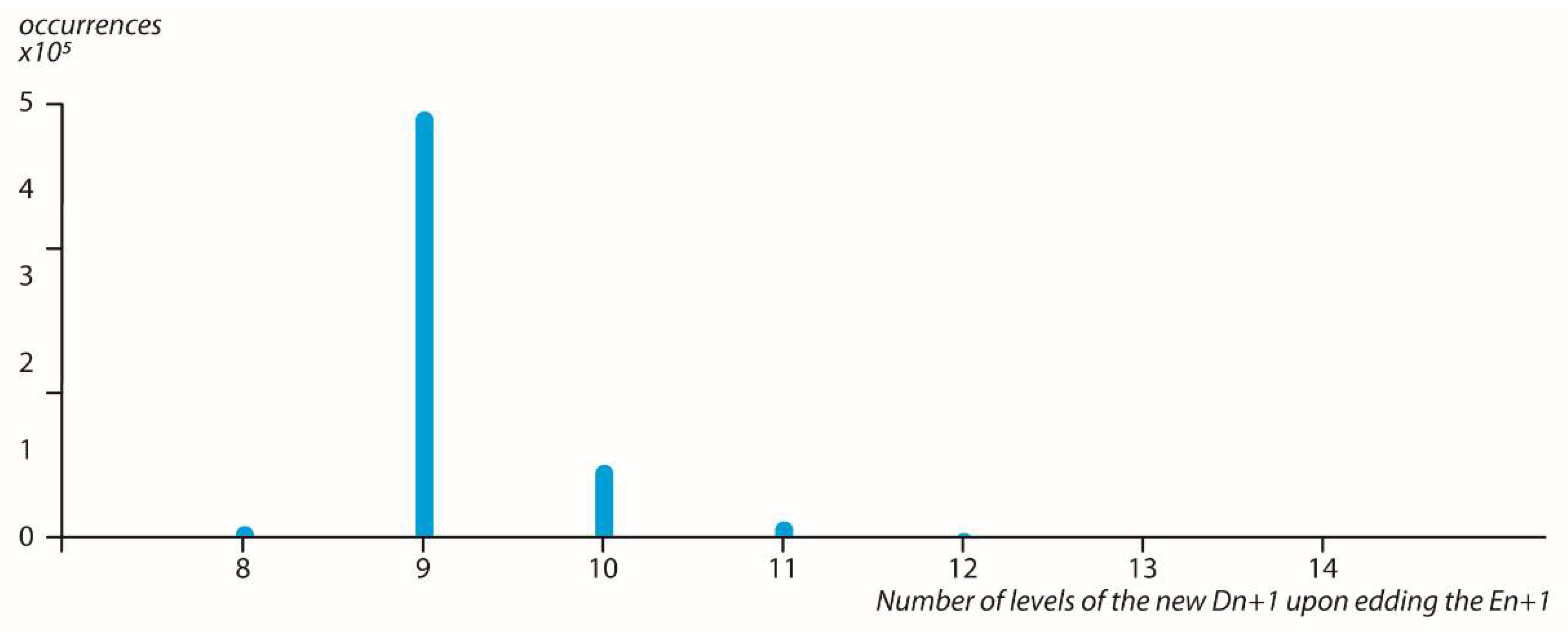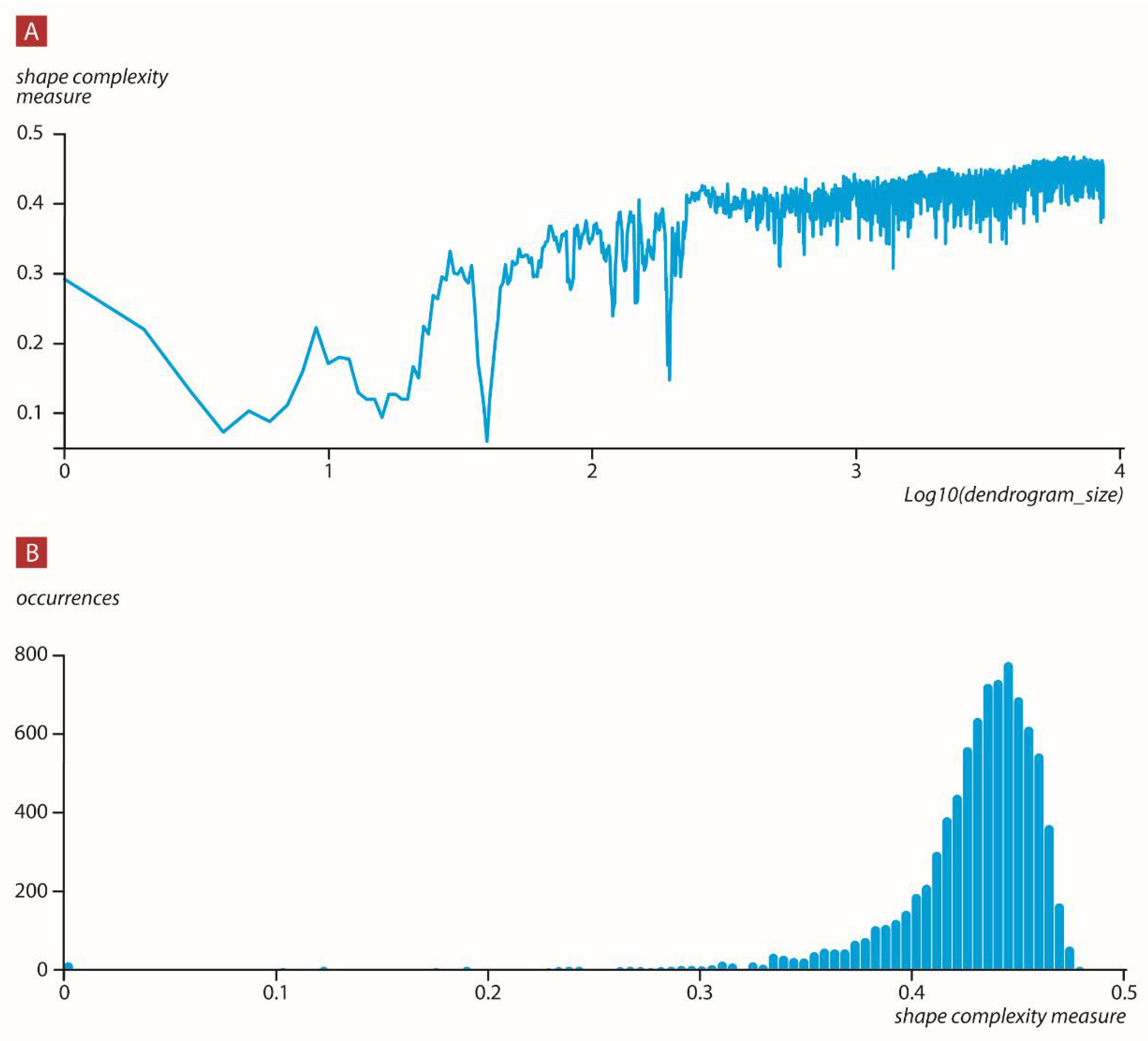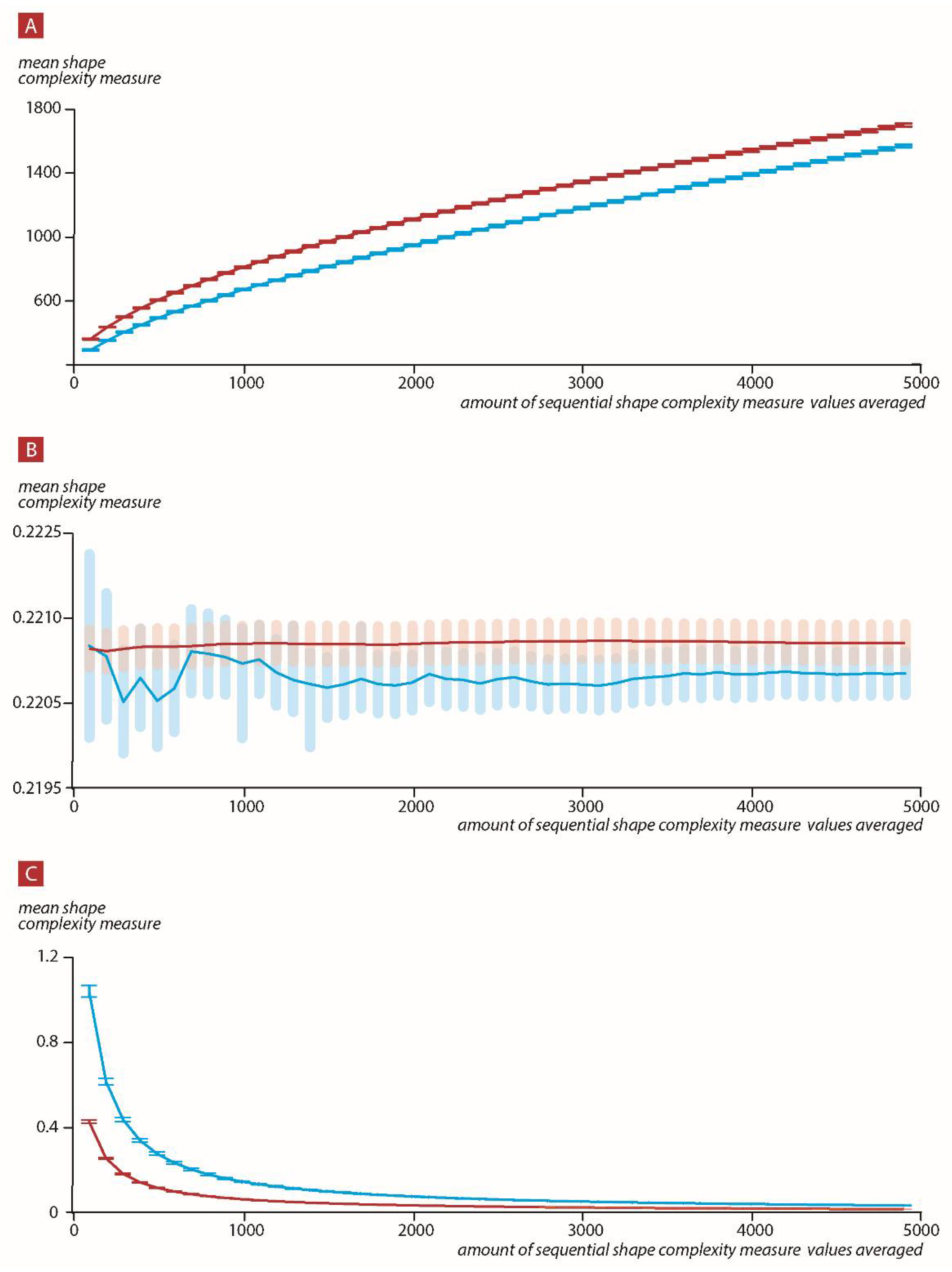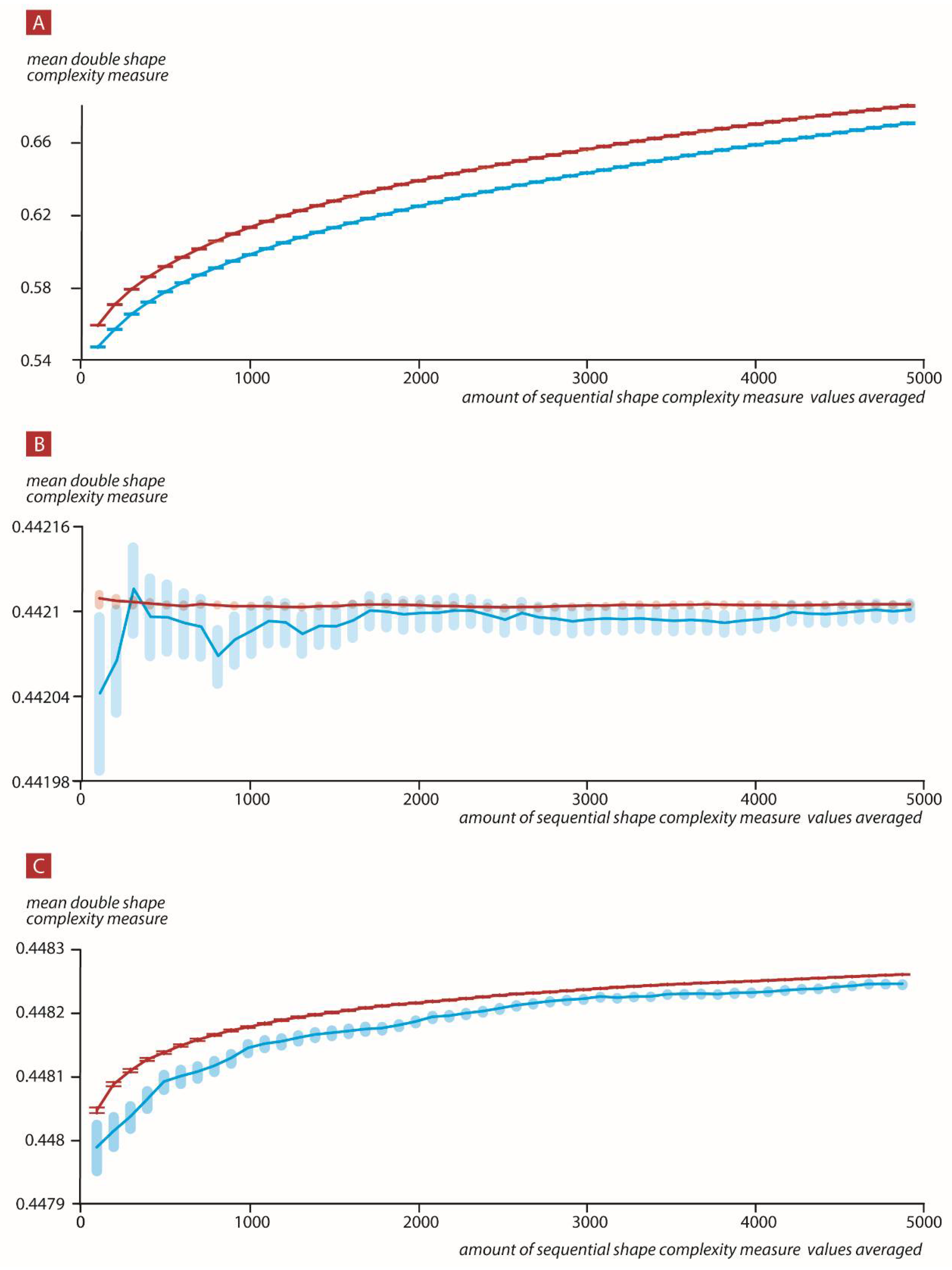1. Introduction
In a series of papers [
1,
2,
3], we developed the basics of Dendrographic Hologram Theory (DH-theory). This theory grew from information physics (starting with Wheeler’s “it from bit” [
4]) and relational event representation of the universe (Smolin et al. [
5,
6,
7,
8,
9,
10,
11,
12,
13]). The latter approach was combined with methods of p-adic theoretical physics, in which physical structures are represented by p-adic numbers (see [
14,
15,
16,
17,
18,
19,
20,
21,
22,
23,
24,
25,
26,
27] for applications to strings and quantum theory; see [
28,
29,
30] for applications to disordered systems (spin glasses)). In contrast to the mainstream, we explore not the number theoretical methods, but the treelike geometry in that p-adic numbers (see
Appendix A) are visualized as the branches of the p-adic tree (a homogeneous tree with
p > 1 edges leaving each vertex). (Treelike geometry was heavily explored in cognitive modeling and psychology [
31,
32,
33,
34,
35,
36]; see also our recent paper on applications of DH-theory to the medical diagnostics of mental disease [
37]).
In DH-theory, elementary events such as outcomes of measurements are represented by the branches of a finite tree, a so-called dendrogram (Cf. with discrete and fractal approach to quantum physics [
38,
39]). The latter by itself represents a complex event combined with elementary events. A dendrogram can be generated from experimental data with the aid of a hierarchic clustering algorithm (although the form of a dendrogram depends on the concrete algorithm, the general structure of the theory is the same for all basic algorithms. In our studies, we use the simplest algorithms of 2-adic, 0/1 (yes-no) clusterization). One of the aims of development of DH-theory is to merge classical and quantum descriptions; the same dendrogramic description of events is used in both cases. The degree of classicality and quantumness of events is characterized by a dendrogram’s size; an increase in size is treated as an increase in classicality (see, e.g., [
2] for application to the violation of CHSH inequality). The merging of classical and quantum descriptions might lead to the resolution of the problem of the creation of quantum gravity.
In complete accordance with the
ontic–epistemic approach to science [
40,
41,
42,
43,
44,
45], DH-theory has two counterparts. The epistemic one is devoted to special (hierarchically relational) structuring of knowledge obtained by an observer from experiments. The ontic one gives the mathematical model of “the universe as it is.” In our theory, the epistemic and ontic descriptions are naturally coupled: They are based on finite and infinite trees, respectively. This paper is based on the results of numerical simulation, and we did not address the ontic model (cf. Refs. [
1,
2,
3]). The epistemic counterpart of DH-theory is briefly presented in
Section 2, and a few words about its ontic counterpart are said in
Section 3.
We studied the dynamics of the event universe generated by the appearance of a new event. Generally, each new event can generate the complete reconstruction of the whole dendrogramic universe. The elementary events created up to the moment t = k are hierarchically ordered via the dendrogram’s structure. The appearance of a new event at t = k + 1 can, in principle, destroy the previous hierarchic structure. The dynamics that are local in the physical space becomes nonlocal in dendrogram space. Thus, all events are permanently in dynamic motion; an event that happened a milliard years ago is not frozen at the same point in dendrogram space; contemporary events disturb it and vice versa: The position of a newly generated event in the dendrogram space is determined by all previous events. The dendrogram universe is in permanent motion and recombination.
Nevertheless, this event motion has some degree of regularity and stability. The appearance of a new event does not generate a totally random redistribution of events. Only very special dendrogramic configurations can be created with high probability.
Total recombination of the events and change in the structure of the event universe can also happen, but with relatively small probability (a kind of catastrophic perturbation of the otherwise stable hierarchic interrelation between events in the universe).
This (unexpected) stability and regularity of the hierarchically coupled event universe is one of the main outputs of our extensive numerical simulation. We understand “stability” as the relative stability of the dendrogram’s structure. The majority of previous events preserve their positions. The number of dendrogram levels is also stable (under the appearance of just one new event). We understand “regularity” as the following feature of the dendrogramic dynamics. The branches of a dendrogram can be represented by vectors with 0/1 coordinates or the corresponding natural numbers in the binary representation. At moment t = k, a dendrogram Dn representing n elementary events has N(Dn) levels. A new elementary event generated at t = k + 1 can in principle be any natural number between 0 and 2N(Dn). However, this new event can take on only very special values (in natural number representation).
We show that even random generation of a new event does not induce a (statistically) crucial redistribution of events on the dendrogram. The graphs of
Figure 1 and
Figure 2 demonstrate some patterns of regularity. As we can also see from
Figure 3, the dendrogramic event universe is essentially stable w.r.t. in the appearance of a new event: With high probability, most events do not change their tree representation.
As was noted, the dendrogram dynamics induced not only a redistribution of events, but also increased the dendrogram’s size and thus its number of levels. Quite trivially, the number of dendrogram levels N = N(Dn) for dendrogram Dn with n events increases with the increase in the number of events n. Similarly, for entropy, N(Dn) can be used to determine the arrow of time. However, in contrast to entropy (governed by the second law of thermodynamics, N(Dn) it has local minimums on the increasing phone.
The increasing number of levels, which is an expectable feature, is not satisfactory enough to serve as a “thermodynamic” law that concerns only the scale-free structure of the dendrogram (in a similar manner we obtained scale-free features of dendrograms as the ratio of dendrogramic constants of nature in a recent study [
3]). Moreover, we need a macro-state function that, given a certain initial size of a dendrogram, will give us some probabilities on the future macro state in the dynamical development of the dendrogram or p-adic string representation of the future events. Each of the macro-states will have a finite number of possible micro states. These micro states are all possible dendrogram structures, where
n is the number of events. The result of evaluating a certain structural feature of all these micro states will correspond to the same macro state value, which is event related. This kind of state function, like entropy, will provide predictive tools for the dendrogramic dynamics of any developing system of events. To capture the scale-free dynamic features of dendrogram dynamics, we use the
shape complexity measure, which was introduced by Barbour et al. in the framework of N-body shape dynamics theory [
46,
47]. In this context we suggest the following definitions.
Definition 1. micro state: Unique dendrogramic structure (coded in a p-adic manner) of relations between events or an event’s p-adic representation of its relation to the rest of the events.
Definition 2. macro state: Certain structural feature value that is the same for different dendrogram structures or a different p-adic representation of events.
Shape dynamics is a field theory describing gravity differently than general relativity. Although the differences between the two theories in most situations are indistinguishable, the two theories have different ontology. Some differences to note are that shape dynamics is not based on space–time representation; instead, the entities in shape dynamics are three-dimensional geometries fitted together by relational principles. These fitted relations results in temporal relationalism: Time emerges from physical changes in shapes. The relational principle of shape dynamics is the Mach–Poincare Principle:
Physical (or relational) initial configurations and their first derivatives alone should determine uniquely the future evolution of the system [
47].
This principle is implemented through an intrinsic derivative, which is called best matching. Best matching allows one, by using only relational data, to say when points are at the same position at different temporal instances. Moreover, Barbour et al. [
10,
11,
12,
13,
14,
15] formulated an intrinsic feature of a system serving as a physically meaningful labeling of change, where the evolution of the structure of a system is towards configurations (i.e., shapes) that maximize the complexity of the system. In what follows we will define this complexity measure in the event/dendrogramic universe. We note that although previous studies in shape dynamics [
9,
10,
11,
12] showed that the complexity increases in both directions away from a Janus point and thus determines the arrow of time in a symmetrical manner away from a Janus point, we cannot produce data in reverse temporal order and thus cannot find a Janus point with its two opposite symmetrical time arrow directions. Thus, our results will indicate an arrow of time directed from past to future only.
The p-adic universe that arises in DH-theory is background independent and fully relational. These properties are in accordance with the loop approach to quantum gravity (LQG) but in contrast to string theory and canonical methods [
5]. In contrast to all quantum gravity theories, DH-theory is inherently “quantized,” not in the regular quantum theory quantization scheme but rather in the unique structure of the p-adic number field. Thus, in DH-theory we do not need to quantize any fields or properties.
We show in
Section 5 that the shape complexity measure can be used as a statistical law of the dynamics of the evolving dendrograms. This statistical law eventually leads to the determination of the arrow of time in a manner similar to the second law of thermodynamics but with different consequences, which will be discussed in
Section 7, and then when operating with entropy [
10,
46,
47].
Our main motivation in this paper is to have the methods and tools to predict the behavior of complex systems. In particular, in the framework of medical diagnosis and as a follow up to our recent study on EEG signals of the brain, these tools will help us to anticipate epileptic and psychotic seizures [
37].
The next two sections are devoted to a brief representation of the foundations of DH-theory. In principle, the reader can jump directly to
Section 4, where we consider the (numerically simulated) dendrogramic dynamics for the simplest physical dynamics given by a randomly generated time series. The latter is transferred into the time series of dendrograms and we study its statistical properties.
2. Brief Introduction to Epistemic DH-Theory
2.1. Info—Physical Principles
Here we briefly recall the basic principles of DH-theory [
1,
2,
3]. This theory is about the representation of special information in the physical universe: event representation (cf. Smolin et al. [
5,
6,
7,
8,
9]).
Principles:
(P1) Event physics. The basic structures in nature are events.
(P2) Relational structures. Interrelations between events are basic structures of the theory.
(P3) Hierarchy. Relational structures are hierarchic.
(P4) Operational representation. An observable A is a composition of preparation and measurement procedures; P and M:A = MP (first preparation and then measurement).
(P5) Event picture of experimental data. Experimental data are used to form the event picture. Elementary events are single datapoints; events are subsets of an experimental dataset.
(P6) Relational observables. Data collected for a physical observable A serve as the input for algorithm Λ for the detection of a relational structure. The composition R = Λ A(=Λ MP) is a relational observable (First preparation, then measurement, and finally clustering algorithm).
(P7) Free will. The assumption of an observer’s free will to select different observables (e.g., axes of PBSs) is extended and an observer O has free will to select an event-relational structure expressed via algorithm Λ.
2.2. Mathematical Formalism
We list the main mathematical methods serving as the base of the DH-theory [
1,
2,
3].
(M1) Hierarchic clustering algorithms. Relational structures are determined by hierarchic clustering algorithms.
(M2) Dendrogramic (treelike) representation. Outputs of relational observables are dendrograms (finite trees). Dendrograms represent events, and their branches (points on the dendrogram’s basement) represent elementary events corresponding to the measurement’s outcomes.
(M3) Ultrametricity. A natural metric on a dendrogram is ultrametric based on the common root of two branches, connecting the tree’s root with points of the basement of a dendrogram.
(M4)
P-adic number encoding of elementary events. Elementary events can be encoded by natural numbers, and the ultrametric is given by the p-adic absolute value (see
Appendix A).
For a big dataset, the set of all subsets is too big. To make the situation numerically treatable, our modeling is restricted to time series, and for each natural number L, observer O can split the series into blocks of length L. These are L-events. Denote this event-selection operation with the symbol Φ = Φ(L). The model is restricted to relational observables in the form R = Λ Φ M P. Consider clustering algorithm Λ = Λ (p) with a p-branching structure, where p > 1 is a natural number.
A
p-adic tree is a homogeneous tree such that, for each node, there is one incoming and
p outcoming wedges. A
p-adic tree with
n levels (branches of length
n) is denoted by the symbol
Z(p,n). Its branches are encoded either by vectors
x = (
x0
x1 …
x(
n − 1)),
xj = 0,…,
p − 1 or by natural numbers {0, 1,…,
pn−1}. In the latter representation,
Z(p,n) has a ring structure with
mod pn addition, subtraction, and multiplication (see
Appendix A).
(M5) Configuration space. The relational observable R = Λ(p) Φ(L) M P takes values in Z(p,n), where n = L − 1.
2.3. Explanatory Comments
(C1)
Causal vs.
relational structures. Typically, causal structures are employed as event-relational structures. However, this leads to the apotheosis of the role of space time (or at least time, as in the works of Smolin et al. [
5,
6,
7,
8,
9,
10]). The use of space time and causal structures based on it led to tremendous success in natural science. However, events can be related not only via causality, but also via more complex relational structures. Moreover, one of the most important physical theories, quantum mechanics, is acausal, at least in some basic interpretations. (Here we do not discuss “quantum nonlocality,” but measurement acausality, which was emphasized by von Neumann. This issue is related to the solution of measurement problems in quantum mechanics and to theories with hidden variables.)
(C3)
Bohr’s principle of complementarity and event physics. Bohr repeatedly stated that outcomes of physical observables are not objective properties of systems but generated in the process of a measurement. This is the basic part of his principle of complementarity [
48]. However, the notion of a system without objective properties is not as foundationally attractive as the notion explored in classical physics. This led to attempts to define systems operationally via measurement outputs. (In private discussions with one of the authors (A.K.H.), Zeilinger defined a photon as photodetector’s click. It is even more natural to consider this click not as the exhibition of the physical system’s existence (in this case, a photon), but as an event.)
(C4) Operational approach to observation. This approach is widely explored in quantum measurement theory. It is closely related to the Copenhagen viewpoint that quantum mechanics is about state preparation and measurement procedures, P and M, respectively, and outputs of the latter. (In particular, originally Feynman’s integral formalism was rejected by Bohr as unphysical, since it handles system trajectories between P and M.) However, most operational researchers still refer to systems.
(C5) Real vs. ultrametric representations. Traditionally, the event approach to physics has been handled within real-number representation by emphasizing the role of space time and the causal structure in it (e.g., Smolin et al.). Geometrically this is a straight-line (multi-dimensional) picture of the universe. However, generally hierarchic relational structures have treelike geometry. This leads to ultrametric representation. One of the simplest and at the same time most well-developed of them is based on p-adic trees. We remark that if p = 1, then the p-adic tree trivializes and coincides with a discretized real line—a lattice.
(C6)
Free will vs.
total determinism. In DH-theory, the hypothesis that an observer
O has free will plays an important role. In physics, free will is treated restrictively as the ability of
O to select settings of measurement devices, e.g., in Bell-type experiments. In the absence of free will the selection of experimental settings would be predetermined. The latter situation is well accommodated under the superdeterminism hypothesis. Although most quantum physicists accept the free will assumption, others do not. Typically, free will vs. superdeterminism are considered mutually exclusive foundational viewpoints. In DH-theory these viewpoints can be brought closer together, as superdeterminism exists as a dynamic law that connects one event to another (see the action principle in [
1,
3]) and free will exists alongside it with the choice, or rather, the willingness, of how many events the observer decides to observe and how he separate these events into different sub-systems of his observable universe [
2]. Thus, in every choice the observer makes his observable universe will still be superdetermined by the dynamic law.
(C7)
Dimensionality of configuration space. In physics configuration, spaces are multidimensional and the dimension by itself carries physical meaning. In DH-theory, all configuration spaces are treelike. They can be visualized in Euclidean space as two-dimensional structures. Moreover, in general topology their dimension can be characterized internally, and it equals zero. Hence, we work with zero-dimensional configuration topological spaces. This possibility to describe events happening in four-dimensional physical space with zero-dimensional topological structures is the essence of the holographic representation, which is basic in DH-theory. Such holography is very special (see [
1] for details and an illustration with a figure).
4. Predictability of an Evolving Dendrogram
We started by examining
n events (
. For that purpose, we generated
n random numbers (in the figures below we show the example for
n = 50, but examining different ns was done with the same qualitative results). From these base n events we constructed a dendrogram
by using the procedure outlined in
Appendix B. We then add another event generated randomly and from the
n + 1 events we compose a dendrogram
.
Thus, for the dendrogram
we have n branches in each path of branch
,
from root to leaf corresponding to event m. Each branch is a string of 1/0, where 1 represents a bifurcation of the branch to the left and 0 is a bifurcation of the branch to the right. This string can be represented by a natural number
by using the p-adic expansion:
Thus, we represent each event as a natural number that corresponds to the event path in the dendrogram.
Our main concern is to understand to what extent we can predict what the natural number representing event in the dendrogram will be. For that purpose, we followed the following procedure:
We randomly generated a base (fixed) events and composed out of it the dendrogram with n edges.
Then, to the same events we added one more event and computed its natural number representation .
We generated the event 6000 times and each time computed its .
We then changed the base events and repeated steps 2 and 3 for these new base events.
We changed the base events 100 times.
We first checked what
(the p-adic expansion representing
) would be in the following case:
does not cause the original dendrogram
(with 50 edges) to change the number of levels in it. So if, for example,
has 9 levels,
has 9 levels as well. As is shown in
Figure 1, the natural number
representing
is very predictable and tends to favor values closer to
in each interval [2
ki 2
ki+1]. We also saw that less than 400 natural numbers were obtained out of 512 such possible numbers.
We also show (in
Figure 2) that given one fixed base of 50 events, only a very limited set of natural numbers resulted that represent the
event: around 80 such natural numbers out of a possible 512 (9 levels of dendrogram). Although in
Figure 1 and
Figure 2 we simulated with
base events dendrograms where
both had a number of levels equal to 9, we witnessed similar qualitative results with 100, 150, 200, …, 500 base events and different numbers of levels.
Moreover, we checked how many
in the
dendrogram changed their natural number representation upon adding the
event with the result of a
dendrogram. This is shown in
Figure 3, which demonstrates the essential stability of the dendrogram representing n events w.r.t. in the appearance of a new event.
Furthermore, we removed the restriction that if
then N(
. Thus, in the case where
but
N(
can have any maximal ball value by adding
, we again witnessed the same qualitative results as in
Figure 1 but with more possible
values (
Figure 4).
We again checked how many edges in the
dendrogram changed their natural number representation upon adding the
with the result of a
dendrogram. We saw (
Figure 5) that although now
resulted in any maximal ball value we obtained the same qualitative result as in
Figure 3, which is with the restriction that if
then
.
Checking the number of levels of the newly formed dendrogram
showed a very significant peak in the maximal ball value of 9 (
Figure 6).
5. Complexity Measures of Events and Dendrograms
Our main motivation in this section is to understand the dynamic process that changes the dendrogram structure upon adding more and more events. In order to obtain a meaningful measure of dendrogramic structure dynamics, we need to overcome the trivial problem that by adding events to a dendrogram we are repeatedly making the dendrogram larger. So, we have a sequence . We therefore need some scale invariant measure of the system.
Interestingly, we showed in a previous study [
3] the scale-free similarities between different sizes of dendrograms and their relations to the constants of nature
. In order to quantify in a scale-free manner the complexity of a dendrogram structure (and even the structure of a single branch in a dendrogram, as detailed below), we decided to use the complexity measure suggested by Julian Barbour in his studies of
N-body shape dynamics.
We first present Barbour’s complexity measure in an
N-body system with
N masses.
5.1. Complexity Measure of Dendrograms
We started from
n = 50 events (random numbers) that were composed in a dendrogram, and then we added one event at a time and composed a dendrogram of
n + 1 events. This procedure was done repeatedly up until event
n = 5000. In order to measure the shape complexity of the dendrogram with
n events, we assigned
where
Vi is the monna map representing the
i′th dendrogram branch p-adic expansion
where
and
k = maximal ball of dendrogram.
By adding more and more events the dendrogram shape complexity measure tended to rise. The mean of the distribution of the shape complexity measure values constantly moved its peak to higher values (
Figure 7).
5.2. Complexity Measure of the Ball Distribution in the p-adic Representation of an Event
We again started from n = 50 events (random numbers) that were composed into a dendrogram, then we added one event at a time and composed the dendrogram of n + 1 events. This procedure was done repeatedly up until event n = 5000. Each time we examined the added event, the n + 1 event, and the branch 1/0 string, and then we calculated the shape complexity measure in the following way: For a string we identified . This is a p-adic ball value.
Again, by adding more and more events, the next event branch string shape complexity measure tended to rise. The mean of the distribution of the shape complexity measure values constantly tended to move its peak to higher values (
Figure 8).
One can argue that these results are trivial, as by sequentially adding one event at a time the dendrogram increases in size and the next event branch path is represented by a longer string. Thus, we moved to a higher N number of “bodies.” In order to show that higher shape complexity values do not depend on a possible larger N number of “bodies” in the system, we turned to our static universe view, which was discussed in our recent papers. We generated a temporal sequence of n random number of events and produced, from all n events, their static representative dendrogram, where their temporal feature was not included in order to form the dendrogram. We then calculated the three-body shape complexity measure obtained from the dendrogram in the following way:
We started with the first h temporal events and marked them as the past of the
h + 1 event. Thus, our three-bodies were the universal past of the
h + 1 event, which is calculated as follows:
where
is a natural number such that
where
and
k = maximal ball of dendrogram.
We represent
as a binary string
and calculate
where
and
k = length of binary string, so the present
where
is the monna map representing the present (
h + 1) dendrogram branch p-adic expansion:
where
and
k = maximal ball of dendrogram, and the center of mass of the present and the past
. We then calculated the above-mentioned shape complexity measure for
h = 50, 51…4950 (thus moving the present each time one event to the future).
For each such temporal sequence we randomized the temporal order of events 10 times and calculated again the complexity measure of the non-temporal ordered sequence. We show the result of the progressing mean values (thus, the mean of values of 1 to
k, where
k = 100, 200, …, 4900) of the complexity measure values in
Figure 9A across all 400 temporal sequences and the progressing mean values of the complexity measures values across all 100 × 400 randomized temporality sequences.
When we moved the present forward one event at a time in the direction of the future produced events, we show, in the figure below, that the shape complexity measure grew with time. Upon reversing the direction of time, we moved the present from the future to the past. Our three-body system was composed of the universal future, where the number of events in the future is (total number of events) −
h event, which is calculated as follows:
where
is a natural number, such that
where
and
k = maximal ball of dendrogram.
We represent
as a binary string
and calculated
where
and
k = length of binary string.
The present is
and was calculated as above, and the center of mass obtained from the present and the past is
. We again calculated the above-mentioned shape complexity measure for
h = 50, 51…4950 (thus moving the present each time one event to the past),where
For the randomized temporal order of events, we again calculated the complexity measure of the non-temporal ordered sequence, now in regards to the present and future as defined above. We show the result of the progressing mean values (thus the mean of values of 1 to
k where
k = 100, 200, …, 4900) of the complexity measure values in
Figure 10B across all 400 temporal sequences and the progressing mean values of the complexity measure values across all 100 × 400 randomized temporality sequences.
As can be seen in
Figure 9A,B, the shape complexity measure always grew when we considered the present direction from past to future (
Figure 9A) in both the past–present system and future to past in the future–present system, where we set the positive direction as for the present moving from the past towards the future. The real temporal order of the sequences resulted in the present–past and present–future system complexity measure values being below the mean of the same systems that are randomized in a non-temporal order.
Again in both simulations, past to future and future to past, we had
increasing in size as a p-adic expansion string. Thus, again one can argue that the size of the universal past/future gets larger, which influences the shape complexity measure to go up. Thus, we need to overcome the argument that one component’s p-adic string
in the three-body system gets increasingly bigger. For that purpose, we again defined the past, present, and future as
as outlined above for
h = 50, 51…4950 (thus moving the present each time one event to the future). As can be seen in
Figure 9C, the shape complexity decreased when considering the whole system of past, present, and future, where we set the positive direction as when the present moves from the past towards the future. Moreover, the real temporal order of the sequences resulted in mean complexity measure values for both systems that were above the mean of the systems that were randomized in a non-temporal order.
The above complexity measures are clearly rational numbers, and as such, not p-adic. Thus, we moved from the p-adic 1-bounded ball, where our dendrogram resides, to the whole of the rational number field. This was an unwanted outcome. In order to overcome this problem, we represented each complexity measure rational number as a p-adic expansion string and calculated the string complexity measure as outlined above. In the figure below we show the results of the p-adic representation of the complexity measure, or, as we call it, the double shape complexity measure.
Please note that the whole universe system went up when the present progressed to the future with an asymptote of the p-adic ball of 2, thus to 2−1. The most interesting feature is revealed in the two top figures, namely, in the past and present system, where the present moved in the direction of the future and the complexity measure increased from values greater then 2−1 and approached values closer to 20, whereas in the future and present system, the present moved in the direction of the future and the complexity measure increased from values greater than 2−2 and approached values closer to 2−1. Thus, the value 2−1 or the p-adic 2 ball was the Janus point of the two systems. These are two “separate” systems that operate dynamically on two different p-adic balls, where in both the time arrow is defined by the complexity measure.
7. Concluding Remarks
DH-theory was created as the novel mathematical representation of natural phenomena, which is an alternative to the standard space–time picture. As posited by, e.g., Smolin et al. [
5,
6,
7,
8,
9,
10,
11,
12,
13,
46], the universe is composed of events, so we work in the event universe. In DH-theory, elementary events are represented by branches of dendrograms (finite trees). We start the paper with a formalization of DH-theory by listing and commenting on its basic structures and briefly presenting its mathematical basis.
The main part of this paper is devoted to studying the dynamics of the event universe generated by the appearance of new events. We found (via extensive numerical simulation) that, surprisingly, the dendrogramic space structure is relatively stable. In principle, the generation of new events can lead to total recombination of the dendrogram’s branches. However, this is not the case (see the histograms in the figures of
Section 4). Even randomly generated events are concentrated at the special sectors of the natural number representation of events (branches), and with high probability the rest of the dendrogram is only slightly modified or even stable. We can say that the dendrogramic universe evolves towards a few special sectors and that this specific evolution is not a consequence of special dynamical laws, but of the treelike structure of the event universe.
We show that, given some initial data, we can predict the future macro state of the system, where this macro state corresponds to a complexity measure value that was first suggested by Barbour and here is implemented on dendrograms and p-adic expansion strings. We note again that the ideology and principles of DH-theory are closely related to shape dynamics (and in fact were inspired by some of the theory’s ideas). The complexity scale-free measure implemented in the p-adic field defines the time arrow, and combined with dendrogram size and natural number probability densities, can be used to predict the dynamic evolution of dendrograms as well as any random number generated sequence. Moreover, we found that the two systems (past–present and present–future) follow the same time arrow, from past to future. The double p-adic complexity measure demonstrates that these two systems operate in two distinct ranges of the p-adic field, where opposite time directions move away from the 2
−1 value. This result is in good agreement with Barbour et al.’s studies of three-body shape dynamics simulations. Thus, overall, the complexity of a system, even if randomly generated, increases. This in turn elevates problems with the entropic law, where increasing disorder, which is in contradiction to the state of the universe, is always expected. We hope that these tools can be implemented in real systems that produce non-random signals in order to predict their dynamics (in particular, biological signals from EEG signals for prediction of unwanted events and conditions [
37]).
DH-theory can be applied to model not only physical, but even biological evolution. Our result supports evolution theory in which the variety of new possible evolutionary events is constrained by the hierarchic relational (treelike) structure of previous events. However, that is a topic for a separate work.
